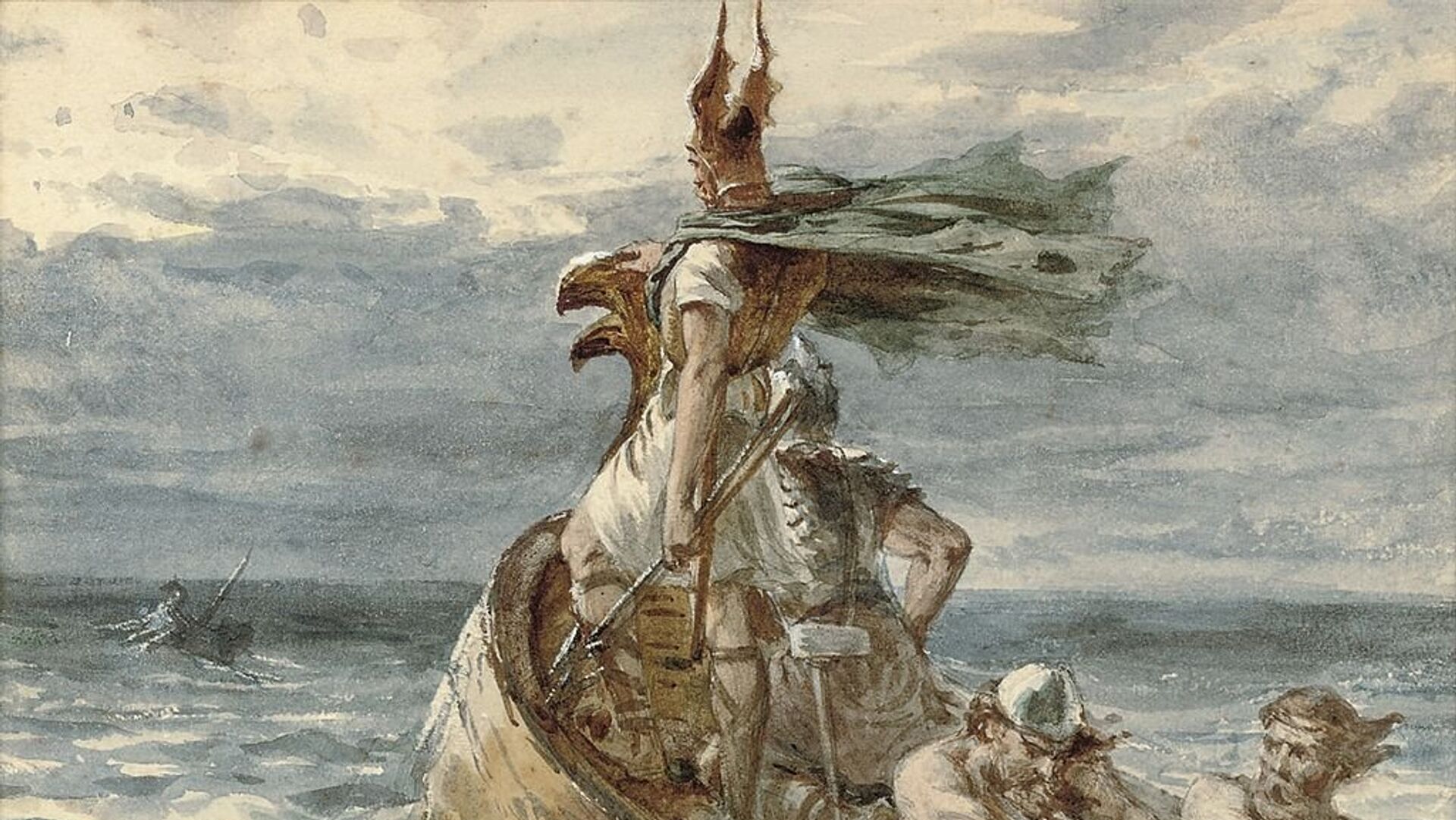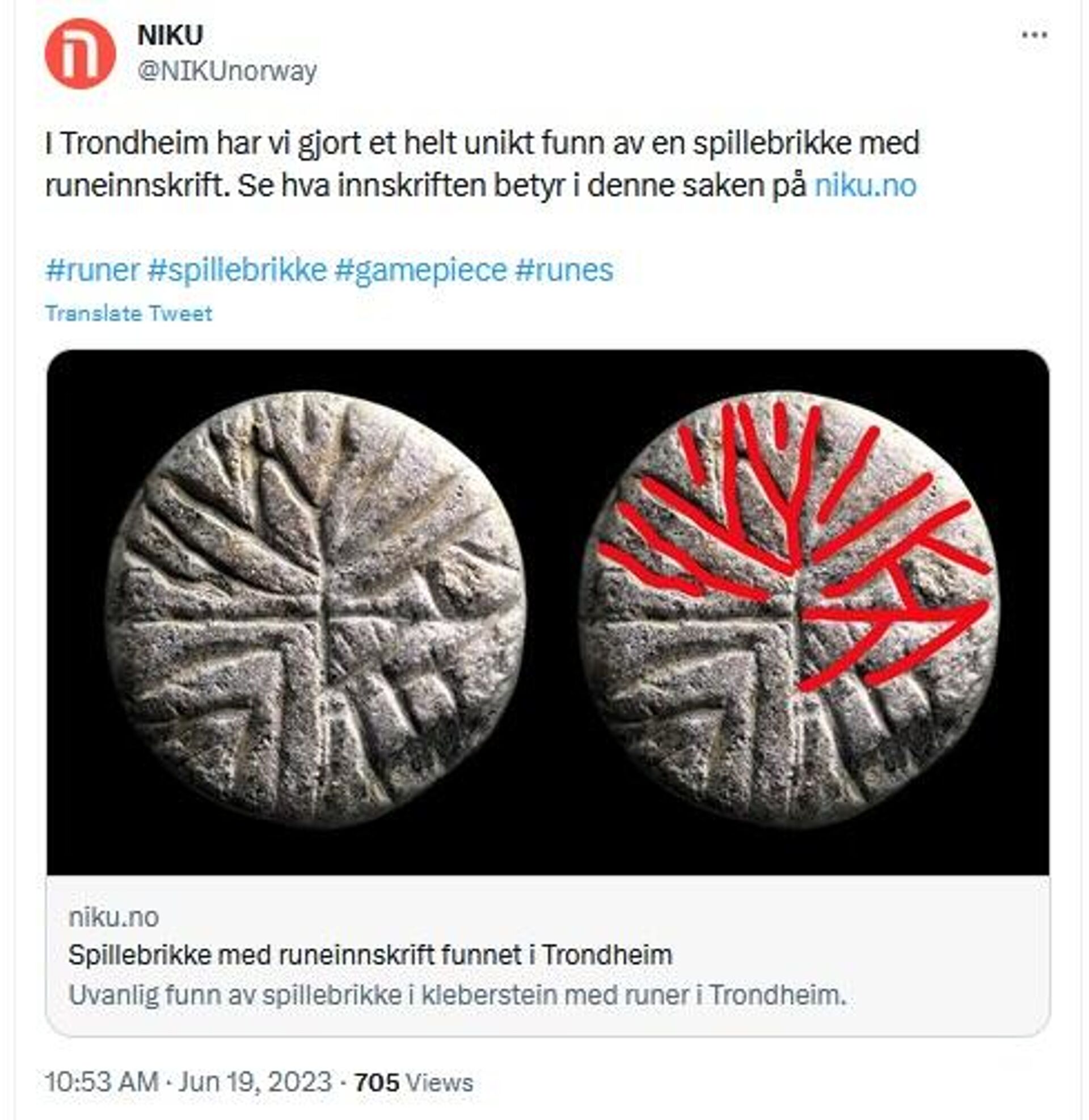https://sputnikglobe.com/20230622/ancient-nordic-board-game-piece-captured-during-norwegian-citys-sewer-repairs--1111381943.html
Ancient Nordic Board Game Piece 'Captured' During Norwegian City's Sewer Repairs
Ancient Nordic Board Game Piece 'Captured' During Norwegian City's Sewer Repairs
Sputnik International
Previously, only two items with runic inscriptions have been unearthed in the city of Trondheim, which makes the find a welcome rarity.
2023-06-22T12:04+0000
2023-06-22T12:04+0000
2023-06-22T12:04+0000
beyond politics
europe
norway
trondheim
christianity
vikings
archeology
ancient treasure
ancient history
https://cdn1.img.sputnikglobe.com/img/106819/06/1068190650_0:0:1024:577_1920x0_80_0_0_e3068482addde56f0373c4709aae6ce7.jpg
A gaming piece inscribed with runes has been discovered during the repair of a sewer pipe in Trondheim, Norway's third most-populous municipality.The soapstone token was found in a layer nearly four meters below the ground between wooden planks that may have been part of a medieval street dating back to between AD 1000 and 1150 and a layer of coal originating sometime between AD 1030 and 1180.So far, only two other items bearing runic inscriptions have previously been found in the city, which is somewhat puzzling given the fact that it served as the medieval capital of Norway for several centuries and was a key trading post.However, what at first glance may look as an uneven geometric pattern, akin to a snow crystal, is in fact a meticulously planned runic inscription. The inscription reads "Siggsifr" and may refer to a hypothetic male name resembling Sigurd, Sigfrid or Sigvard (with an "R" at the end signifying a man in Old Norse grammar), or a poetic word translating as "battle brother" or, more broadly, "brother in arms." This may refer to the person who made the piece or the person who played the game. Lastly, the token may have served as a king piece.An intricate decorative pattern was craftfully inscribed on parts of the stone where there were no runes.While runic inscriptions are a rarity, ancient gaming pieces as such are not. The Vikings in particular loved board games and had a whole family of strategic games called Tafl, played on checkered on latticed game boards with pieces representing rivaling armies. The Vikings famously brought their games on their travels and were buried with boards and pieces.During medieval times, following the spread of Christianity, gambling started to be seen as a hazard. King Magnus the Law-mender's city laws from the late 13th century stipulated that anybody found gambling with money would have it confiscated and would be fined.
norway
trondheim
Sputnik International
feedback@sputniknews.com
+74956456601
MIA „Rossiya Segodnya“
2023
News
en_EN
Sputnik International
feedback@sputniknews.com
+74956456601
MIA „Rossiya Segodnya“
Sputnik International
feedback@sputniknews.com
+74956456601
MIA „Rossiya Segodnya“
viking age, medieval gaming, ancient board games, viking board games, archeological find, medieval norway
viking age, medieval gaming, ancient board games, viking board games, archeological find, medieval norway
Ancient Nordic Board Game Piece 'Captured' During Norwegian City's Sewer Repairs
Previously, only two items with runic inscriptions have been unearthed in the city of Trondheim, which is somewhat odd given that it served as the medieval capital of Norway for centuries and was a key trading post.
A gaming piece inscribed with runes has been discovered during the repair of a sewer pipe in Trondheim, Norway's third most-populous municipality.
The soapstone token was found in a layer nearly four meters below the ground between wooden planks that may have been part of a medieval street dating back to between AD 1000 and 1150 and a layer of coal originating sometime between AD 1030 and 1180.
So far, only two other items bearing runic inscriptions have previously been found in the city, which is somewhat puzzling given the fact that it served as the medieval capital of Norway for several centuries and was a key trading post.
However, what at first glance may look as an uneven geometric pattern, akin to a snow crystal, is in fact a meticulously planned runic inscription. The inscription reads "Siggsifr" and may refer to a hypothetic male name resembling Sigurd, Sigfrid or Sigvard (with an "R" at the end signifying a man in Old Norse grammar), or a poetic word translating as "battle brother" or, more broadly, "brother in arms." This may refer to the person who made the piece or the person who played the game. Lastly, the token may have served as a king piece.
An intricate decorative pattern was craftfully inscribed on parts of the stone where there were no runes.
While runic inscriptions are a rarity, ancient gaming pieces as such are not.
The Vikings in particular loved board games and had a whole family of strategic games called
Tafl, played on checkered on latticed game boards with pieces representing rivaling armies.
The Vikings famously brought their games on their travels and were
buried with boards and pieces.
During medieval times, following the spread of
Christianity, gambling started to be seen as a hazard.
King Magnus the Law-mender's city laws from the late 13th century stipulated that anybody found gambling with money would have it confiscated and would be fined.



